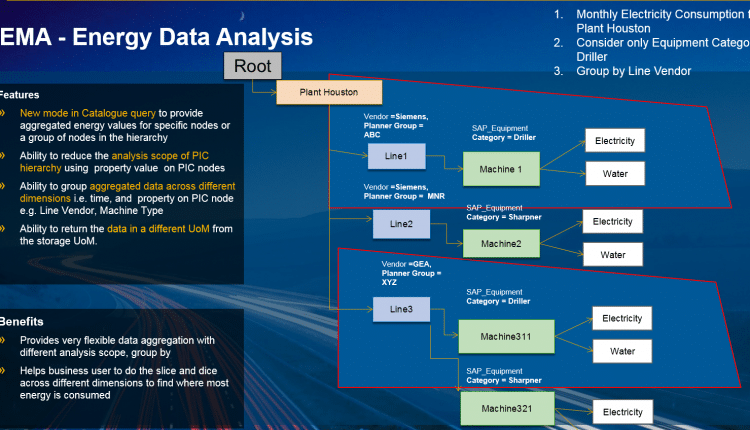Energy Monitoring and Analysis with MII 15.1
Energy Monitoring and Analysis with MII 15.1: Manufacturing companies need to keep track of some of the key cost in order to be competitive in the market. One of the most important aspect is energy cost which play a key factor in the cost of the material being produced. They need to have a complete visibility of energy consumption by line, product etc so that it is easy to identify any leaks and hence take corrective action. Generally, customer tend to create custom applications on top of MII to do the energy analysis which are not flexible and easy to roll out to multiple plants. Keeping this in the mind, MII provided capability of energy monitoring and analysis as part of SAP MII 15.1. the main objective is collect the energy data once without any business context and provide analytic capabilities with context available in PIC and production events i.e. order history, resource status available in SAP OEE, SAP ME or any 3rd party system. Here is how you can use the energy monitoring capability in MII which is a very good use case of IT, OT convergence providing the ability to do energy analysis across your plant structure depicted as PM/PP hierarchy coming from IT system and meter data coming from OT layer.
1. Master Data – one of the key master data for energy analysis is defining the hierarchy structure against which the analysis needs to be done i.e. facility hierarchy, organization hierarchy depicting complete structure including the meter. Plant information catalog can be used to model the different hierarchy sharing the different meter represented as tag categories i.e. Electricity, water, compressed air. The properties on each of the nodes can be used for filtering the energy data i.e. energy information only for machine type Driller or providing the grouping of the data i.e. energy information grouped by line vendor.

2. Meter Data Collection – The next important aspect is collecting the meter data against the meter ID at a regular interval i.e. 1, 5, 10 mins etc without any functional dimension. For this purpose KPI object is being used to collect equi-distant energy data. KPI has been enhanced to support collecting equi-distant energy data and providing analysis lower than 1 hours.

KPI definition with equidistant storage interval

Data Snapshot for different meter based on equidistant interval

KPI query providing data aggregated lower than 1 hour
3. Linking Hierarchies with Meter Data – once the master data and transaction data is defined, it needs to be linked for the analysis. For this, Tag node in Plant Information Catalog is enhanced to map it to a KPI with appropriate dimension filter defined for that tag.

PIC Tag node linked with KPI storing meter data

Pictorial view of data snapshot after mapping
4. Energy Analysis – Once the above data modeled is created and linked, it should be possible to ask different queries to this data model. For this a new mode in catalog query called PIC analysis is defined where you can provide following information
a. Tag categories i.e. electricity, water etc. for which aggregated information is required.
b. Granularity – Granularity at which data needs to be returned i.e. monthly, hourly etc.
c. Starting nodes for which the aggregated data is needed.
d. Any filter based on different properties on the PIC nodes.
e. Any group by based on different properties on the PIC nodes.

Typical query example

Defining energy type, Granularity etc

Grouping node for which aggregated data is needed.

Filtering the scope of aggregation based on filter condition on node properties value.

Grouping the aggregated data based on properties on different nodes
5. Energy Dashboard – the final goal for energy monitoring is providing role based energy dashboard based on different requirements. MII SSCE has been enhanced to provide simplified energy dashboard. Some of the key improvements are as following.
a. Easy integration of PIC analysis query by providing overriding capability of any of the parameters.
b. Visualizing energy data into Chart.
c. Unified change of PIC node and time period at the dashboard level.
d. Ability to see the energy information on Map.

Uniform Time change from the top for the dashboard

Uniform PIC node change from top

Example dashboard with different chart type and on the map.

Example dashboard with tile view
as you can see from above information, customer can easy do energy monitoring and analysis based on their needs primarily because there is no data model delivered by SAP for this. Everything is flexible in terms of hierarchy, the properties on each of the hierarchy nodes, queries, and dashboard creation.
New NetWeaver Information at SAP.com
Very Helpfull
